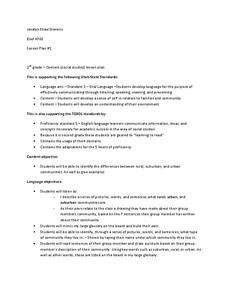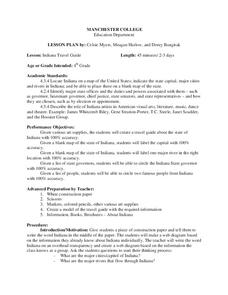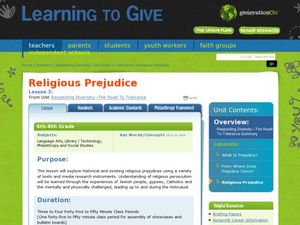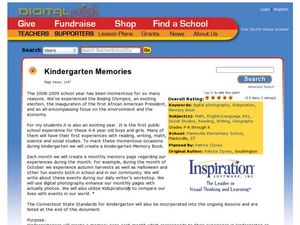Curated OER
Classification of Intertidal Organisma
Students categorize animals. In this animal classification lesson, students group animals by their characteristics. Students break into groups and work together to classify the animals. Students fill out a graphic organizer with their...
Curated OER
Kids Need Natural Resources
Third graders define renewable and non-renewable resources and give multiple examples of each type of resource. In this environmental science lesson, 3rd graders sort picture cards into two categories, renewable and non-renewable...
Curated OER
A Readers' Theatre for Bringing the Rain to Kapiti Plain
Second graders read and perform a reader's theater version of the story, "Bringing the Rain to Kapiti Plain." They complete a graphic organizer of cause and effect of their part in the story, look up vocabulary words on a dictionary...
Curated OER
Number The Stars: Character Sketch
In this literacy worksheet, students create a graphic organizer for the character of Anne Marie from Number The Stars. Then they write a description of her.
Curated OER
Types of Rock
In this rocks worksheet, students compare and contrast the 3 types of rocks: sedimentary, igneous, and metamorphic. Students complete 1 graphic organizer.
Curated OER
Plot Development
Young scholars identify the elements of plot and write a script with a strong plot. In this plot instructional activity, students identify elements of plot in examples by completing a chart and a graphic organizer. Young...
Curated OER
Face the Nation! A Panel Discussion
Sixth graders simulate an election-year debate between opposing political parties. For this persuasive-speech lesson plan, 6th graders will work in teams to prepare for and participate in a debate between opposing parties. The lesson...
Curated OER
Retelling Problems and Solutions in Chronological Order
First graders discover how to retell problems and solutions in a story in chronological order. In this chronological order lesson, 1st graders use graphic organizers to record information. Students then use this information to sequence...
Ohio Department of Education
I Can Name that Angle in One Measure! - Grade Eight
Collaborative groups work with geometry manipulatives to investigate conjectures about angles. They create a graphic organizer to use in summarizing relationships among angles in intersecting, perpendicular and parallel lines cut by a...
National Endowment for the Humanities
Thirteen Ways of Reading a Modernist Poem
High schoolers analyze modernist poetry and the role of speaker in example poems. Learners study modernist poems from the Romanticism and Victorian periods as well as Wallace Stevens' "Thirteen Ways of Looking at a Blackbird." Using a...
Creative Chemistry
Formulae of Ionic Compounds - Practice
In this compound worksheet, students complete a graphic organizer by combining positive and negative ions appropriately and writing down the resulting compound.
Curated OER
What is a Community?
Second graders write sentences in a graphic organizer about communities and what they include. In this community lesson, 2nd graders will also draw a picture based on their description.
Curated OER
Indiana Travel Guide
Fourth graders share their information about their home state. For this research lesson, 4th graders use graphic organizers to make a travel guide about the state of Indiana. This lesson could be modified for use with any state, it also...
Alabama Learning Exchange
President's Day for Special Education/Early Elementary
Students investigate how both Abraham Lincoln and George Washington displayed the trait of honesty. They listen to read alouds of class books and poems that address both the lives of these men and the trait of honesty. They use a graphic...
Curated OER
The Lynx Eats The Hare
Students investigate the predator and prey relationship. This is done using a simple simulation. The simulation is done as an arts and craft activity. Students record data and track it using a graphic organizer and then they discuss the...
Curated OER
Everything Grows
First graders read about the growth of living things. In this similiarities and differences instructional activity, 1st graders list things that are similiar and different about growing plants. Students then use a graphic organizer to...
Curated OER
Our Solar System
In this solar system worksheet, students complete a database comparing the 9 different planets' mass, surface temperature, rotation period, orbital period, moons, and distinguishing features. This worksheet is a graphic organizer.
Curated OER
What Do I Know About Islands
In this island research worksheet, students fill in a graphic organizer about the island of their choice. Students fill in two tables with advantages and disadvantages of living on the Rathlin Island and Hallig Oland. They write a...
Curated OER
Sun-Shadow Mandala Worksheet
In this Sun-Shadow Mandala Worksheet, students complete a graphic organizer and create an original mandala. Students are given 8 categories with related questions as a guide.
Curated OER
Our Five Senses
Learners use their five senses to describe what's in a mystery bag. For this senses lesson, students use a graphic organizer to collect words for a sensory poem.
Curated OER
Respecting Diversity- The Road to Tolerance
Students use a graphic organizer to find similarities and differences in three religions. In this prejudice instructional activity, students understand the events leading up to the holocaust. Students understand that people who respected...
Curated OER
Kindergarten Memories
Students create a monthly memory and compile it into a Kindergarten Memory Book. In this memory book lesson, students create a monthly memory page. Students create a graphic organizer in Kidspiration which is developed into a...
Curated OER
Battering Through the Seasons
Students define bartering and barter to investigate supply and demand. In this bartering activity, students read A New Coat for Anna and recall how they exchanged merchandise in the story. Students complete a sequential graphic...
Curated OER
Situation of America, 1848
Students explore 19th century American artwork. In this cross curriculum New York history and art appreciation lesson, students view a reproduction of the painting "Situation of America, 1848," and identify visual symbols and...























